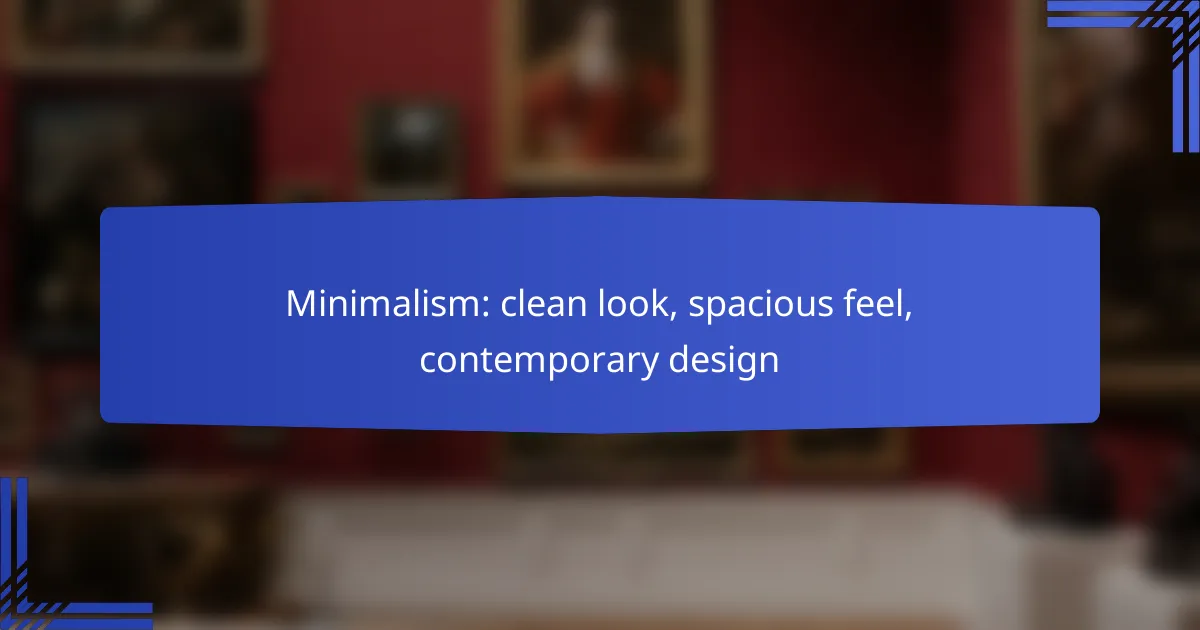Minimalism in interior design prioritizes simplicity and functionality, creating a clean aesthetic that enhances the spacious feel of a home. By utilizing neutral colors and thoughtfully chosen furnishings, minimalist spaces promote a sense of calm and order, allowing essential elements to shine. This contemporary design approach not only looks visually appealing but also fosters practicality and serenity in everyday living.

How to achieve a minimalist design in London homes?
To achieve a minimalist design in London homes, focus on simplicity, functionality, and a clean aesthetic. This approach emphasizes open spaces, neutral colors, and carefully selected furnishings to create a serene environment.
Use neutral color palettes
Neutral color palettes are essential for minimalist design, as they create a calm and spacious atmosphere. Shades like white, beige, gray, and soft pastels can make rooms feel larger and more inviting.
Consider using these colors on walls, furniture, and decor to maintain a cohesive look. Accents in darker or bolder hues can be introduced sparingly to add interest without overwhelming the space.
Incorporate multifunctional furniture
Multifunctional furniture is key in minimalist design, especially in smaller London homes. Pieces that serve multiple purposes, such as a sofa bed or an ottoman with storage, help maximize space and reduce clutter.
When selecting furniture, prioritize items that combine style and utility. This approach not only saves space but also enhances the overall aesthetic by keeping the design streamlined.
Maximize natural light
Natural light is a crucial element in minimalist design, as it enhances the feeling of openness. Use sheer curtains or no window treatments at all to allow sunlight to flood the space.
Consider strategically placing mirrors to reflect light and create an illusion of depth. This can make even smaller rooms feel airy and expansive, aligning with the minimalist ethos.
Declutter spaces
Decluttering is vital for achieving a minimalist look. Remove unnecessary items and keep surfaces clear to maintain a clean and organized environment. Aim for a few carefully chosen pieces that serve a purpose or bring joy.
Regularly assess your belongings and consider adopting a “one in, one out” rule to prevent accumulation. This practice helps maintain the minimalist aesthetic over time.
Choose simple decor
Simple decor is fundamental in minimalist design, emphasizing quality over quantity. Opt for a few statement pieces rather than numerous decorative items to avoid visual clutter.
Artworks, plants, or sculptures should be thoughtfully selected to complement the overall design. Choose designs that reflect clean lines and understated elegance, enhancing the minimalist feel of your home.

What are the benefits of minimalism in interior design?
Minimalism in interior design offers numerous benefits, including a clean aesthetic, enhanced functionality, and a sense of spaciousness. By focusing on essential elements, minimalism creates environments that are both visually appealing and practical.
Creates a spacious feel
Minimalist design emphasizes open spaces and uncluttered layouts, which contribute to a feeling of spaciousness. By reducing the number of furnishings and decorative items, rooms can appear larger and more inviting.
To achieve this effect, consider using furniture that serves multiple purposes, such as a sofa bed or storage ottoman. Additionally, opting for lighter colors on walls and floors can enhance the airy atmosphere.
Enhances focus and tranquility
A minimalist environment promotes focus and tranquility by eliminating distractions. With fewer items vying for attention, individuals can concentrate better on tasks and enjoy a more peaceful atmosphere.
Incorporating natural elements, such as plants or natural light, can further enhance this sense of calm. Aim for a balanced arrangement that fosters relaxation while maintaining functionality.
Reduces maintenance efforts
Minimalism simplifies cleaning and upkeep by limiting the number of surfaces and items that collect dust and dirt. Fewer decorative pieces mean less time spent on maintenance, allowing for a more efficient living space.
To maximize this benefit, choose materials that are easy to clean and durable. For instance, opting for smooth surfaces like glass or metal can reduce the effort needed to maintain a tidy home.

What are key principles of minimalist design?
Key principles of minimalist design focus on simplicity, functionality, and the effective use of space. This approach emphasizes a clean aesthetic that promotes a sense of calm and order, allowing essential elements to stand out.
Simplicity in form and function
Simplicity in form and function means stripping away unnecessary elements to highlight what truly matters. This involves using clean lines, basic shapes, and a limited color palette to create a cohesive look. For example, a minimalist chair may have a straightforward silhouette without ornate details.
When designing a minimalist space, prioritize essential furniture and decor that serve a purpose. Avoid clutter by selecting items that are both functional and visually appealing, ensuring each piece contributes to the overall design.
Emphasis on quality over quantity
Minimalist design emphasizes quality over quantity by encouraging the selection of fewer, high-quality items instead of many lower-quality ones. This principle suggests investing in durable materials and timeless designs that withstand trends and wear. For instance, a well-crafted wooden table can be a centerpiece that lasts for years.
To apply this principle, consider the longevity and craftsmanship of each item before purchase. Focus on acquiring versatile pieces that can adapt to different uses or settings, reducing the need for multiple items.
Integration of open spaces
Integration of open spaces is crucial in minimalist design, as it creates a sense of freedom and tranquility. Open spaces allow for natural light to flow and enhance the overall ambiance. This can be achieved by using fewer walls and opting for open floor plans that connect different areas seamlessly.
When designing a minimalist environment, aim to maintain clear sightlines and avoid overcrowding. Use furniture arrangements that promote flow and accessibility, ensuring that each area feels spacious and inviting. Incorporating large windows or glass doors can further enhance the openness of the space.

How to select minimalist furniture for small spaces?
Selecting minimalist furniture for small spaces involves choosing pieces that maximize functionality while maintaining a clean aesthetic. Focus on items that are compact, versatile, and visually light to create an open and airy environment.
Opt for sleek lines and shapes
Sleek lines and simple shapes are essential in minimalist furniture design, as they help to create a sense of spaciousness. Look for furniture with straight edges, rounded corners, and unobtrusive designs that do not overwhelm the room.
For example, a low-profile sofa with a straight back and narrow arms can fit seamlessly into a small living area, while a round coffee table can soften the look without taking up too much visual space.
Prioritize lightweight materials
Choosing lightweight materials is crucial for minimalist furniture, as they contribute to a less cluttered feel. Materials like metal, glass, and light woods can create an airy atmosphere while being easy to move and rearrange.
Consider options such as a glass dining table or a lightweight aluminum chair, which can be easily shifted to accommodate different activities or layouts without feeling bulky.
Consider modular designs
Modular furniture is ideal for small spaces, as it offers flexibility and adaptability. Look for pieces that can be rearranged or combined in various configurations to suit your needs.
For instance, modular sofas can be reconfigured for different seating arrangements, while stackable chairs can be stored away when not in use, maximizing your available space without sacrificing style.

What are common mistakes in minimalist design?
Common mistakes in minimalist design include overcrowding spaces with decor and neglecting personal style. These errors can detract from the intended clean and spacious feel that minimalism aims to achieve.
Overcrowding with decor
One of the most frequent pitfalls in minimalist design is overcrowding spaces with too many decorative items. While it may be tempting to fill empty areas, this can lead to a cluttered appearance that contradicts the minimalist ethos. Aim for a few carefully selected pieces that enhance the space without overwhelming it.
To avoid overcrowding, consider the principle of “less is more.” A good rule of thumb is to limit decorative items to one or two per surface area, allowing for breathing room and visual clarity. This approach not only maintains a clean look but also highlights the beauty of each piece.
Neglecting personal style
Another common mistake is neglecting personal style in the pursuit of minimalism. While a minimalist aesthetic often emphasizes simplicity, it should still reflect the individual’s tastes and preferences. Striking a balance between minimalism and personal expression is crucial for creating a space that feels inviting and authentic.
Incorporate elements that resonate with you, such as unique art pieces or heirlooms, but do so sparingly. Choose items that serve a purpose or hold sentimental value, ensuring they contribute to the overall harmony of the space. This way, your minimalist design remains true to your identity while achieving a contemporary look.
